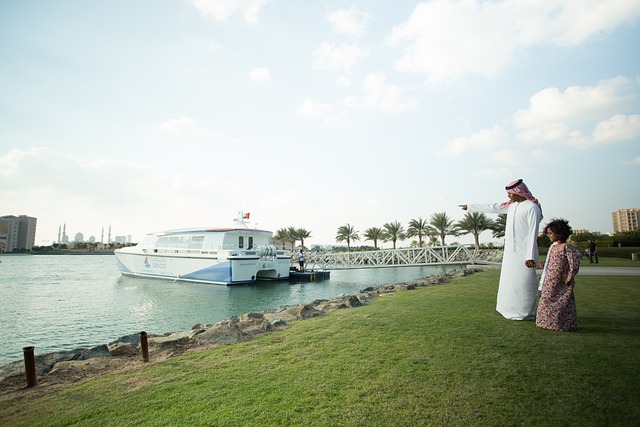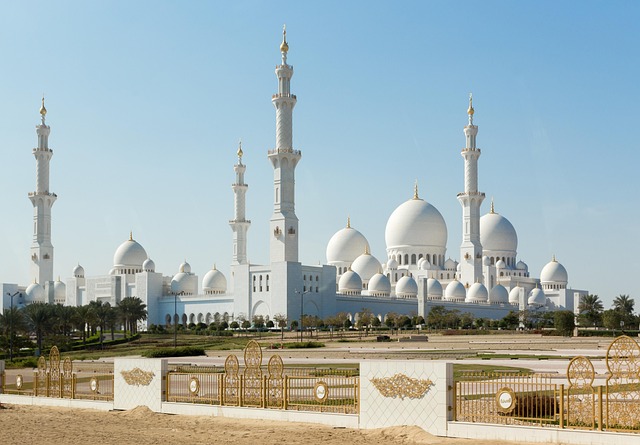In the dynamic cities of Abu Dhabi and Dubai, efficient high-speed transfers are crucial due to increasing traffic congestion and growing business & leisure travel. Modern transportation options, from private cars to shared rides, cater to diverse needs. High-speed rail, smart infrastructure, and digital integration significantly reduce travel time between these hubs. Key routes focus on direct connections between international airports AUH and DXB, with growing interest in secondary airports. Challenges include peak-time routing and robust infrastructure maintenance. Successful initiatives utilize electric vehicles, real-time tracking, and advance booking platforms. The future looks promising with expansions like dedicated transport corridors and advancements like autonomous vehicles & hyperloop systems.
“Experience the future of travel with high-speed transfers between Abu Dhabi and Dubai—a transformative solution redefining mobility. As the region’s bustling hubs, these cities demand efficient connectivity. This article explores the imperative for swift transfers, delving into the current market, technological advancements, and their impact on passenger experiences. We analyze popular routes, address implementation challenges, and showcase successful initiatives. Get ready to discover how high-speed transit is revolutionizing journeys between these iconic destinations.”
- Understanding the Need for High-Speed Transfers
- The Current Landscape of Airport Transfer Services in Abu Dhabi and Dubai
- Advantages of High-Speed Transfers: Why Go Faster?
- Key Technologies Driving High-Speed Transit
- Exploring Popular Demand Patterns and Routes
- Challenges and Considerations for Implementation
- Case Studies: Successful High-Speed Transfer Initiatives
- Future Prospects and Predictions
Understanding the Need for High-Speed Transfers

In the bustling metropolises of Abu Dhabi and Dubai, where business and leisure travel thrive, understanding the need for efficient and high-speed transfers is paramount. The rapid growth of these cities has led to increased traffic congestion, making traditional transportation methods less desirable for time-sensitive journeys. Airport transfer services in particular have become a game-changer, offering commuters and tourists alike a swift and comfortable alternative.
High-speed transfers, especially between major hubs like Abu Dhabi and Dubai, cater to the demanding schedules of modern travelers. By providing direct and efficient routes, these services reduce travel time significantly. Whether it’s for business meetings or exploring tourist attractions, travelers now have access to reliable transportation options that align with their fast-paced lifestyles.
The Current Landscape of Airport Transfer Services in Abu Dhabi and Dubai

In the dynamic cities of Abu Dhabi and Dubai, efficient airport transfer services are a cornerstone of modern travel. The current landscape is characterized by a multitude of options catering to diverse needs, from luxurious private cars to cost-effective shared rides. High-speed transfers between Abu Dhabi and Dubai have become increasingly popular due to the growing business and leisure traffic between these two hubs. These transfers not only streamline journeys but also offer travelers a glimpse into the region’s rapid development and interconnectedness.
The competition among airport transfer providers has led to significant innovations, including advanced booking systems, real-time tracking, and a range of vehicle types to suit different budgets and preferences. Services like Abu Dhabi to Dubai private airport transfers have gained traction for their convenience, comfort, and reliability. This evolution reflects the region’s commitment to enhancing passenger experiences, ensuring that every trip between these iconic destinations is as smooth and stress-free as possible.
Advantages of High-Speed Transfers: Why Go Faster?

High-speed transfers between Abu Dhabi and Dubai offer a multitude of advantages, making them an increasingly popular choice for both business travelers and tourists. The primary benefit is, of course, speed. With modern transportation systems like high-speed rail or dedicated highways, commutes that once took hours can be reduced to just a few minutes. This means less time spent traveling and more time for other activities, whether it’s catching up on work, relaxing, or exploring new destinations along the way.
In the context of airport transfers from Abu Dhabi to Dubai, high-speed options significantly enhance the overall travel experience. Passengers can bypass the traffic congestion often encountered on traditional routes, arriving at their destination feeling less stressed and more relaxed. Moreover, these efficient transfer methods can be particularly beneficial for those with tight schedules, ensuring they reach their flight gates or business meetings on time.
Key Technologies Driving High-Speed Transit

The high-speed transit revolution between Abu Dhabi and Dubai is made possible by cutting-edge technologies, transforming travel experiences in the region. One of the primary enablers is high-speed rail, which offers a seamless and efficient connection between these bustling metropolises. These trains are designed to navigate extensive distances with remarkable speed, reducing travel time significantly compared to traditional modes of transport like road or air. Advanced signaling systems, such as European Train Control System (ETCS), play a pivotal role in ensuring safe and timely operations. ETCS allows for precise control and monitoring of train movements, enabling high-speed runs while maintaining safety standards.
Additionally, smart infrastructure and digital integration are integral to the success of these high-speed transit systems. Sensor technology and real-time data analysis optimize route planning and traffic management, ensuring efficient operations. Airport transfer Abu Dhabi to Dubai benefits from these innovations, providing passengers with faster, more reliable journeys. The seamless integration of various technologies creates a modern transportation network that caters to the demands of a growing population in the region.
Exploring Popular Demand Patterns and Routes

The high-speed transfer between Abu Dhabi and Dubai caters to a vibrant exchange of passengers and cargo, driven by the bustling economic activity in both cities. Exploring popular demand patterns reveals that airport transfer Abu Dhabi to Dubai is a top priority for both business travelers and tourists looking to navigate these metropolis efficiently. Key routes include the direct connection from Abu Dhabi International Airport (AUH) to Dubai International Airport (DXB), serving as the lifeline for daily commuters, business meetings, and leisure trips.
Beyond the primary route, secondary demand patterns show a growing interest in transfers between secondary airports like Al Maktum International Airport (DXW) in Dubai and various locations within Abu Dhabi, reflecting the expanding reach of both cities’ influence. These demand dynamics underscore the need for reliable, high-speed transfer options, driving continuous innovation and improvement in transportation infrastructure to meet the evolving needs of this dynamic region.
Challenges and Considerations for Implementation

Implementing high-speed airport transfers between Abu Dhabi and Dubai presents several unique challenges. One significant hurdle is the logistics of managing frequent and efficient routes, especially during peak travel times when congestion is a constant concern. The bustling nature of both cities demands a robust transportation network that can accommodate a large volume of travelers without compromising speed and comfort.
Another consideration is the infrastructure required to support such rapid transit. This includes not only well-maintained roads but also advanced traffic management systems to ensure smooth flow. Additionally, integrating these transfers seamlessly with existing airport facilities and transport networks in both cities is vital for a successful implementation. Effective communication strategies are essential to manage passenger expectations and ensure a seamless experience, particularly when dealing with potential delays or route changes.
Case Studies: Successful High-Speed Transfer Initiatives

Successful high-speed transfer initiatives between Abu Dhabi and Dubai have significantly enhanced connectivity and travel experiences for residents and visitors alike. One notable example is the introduction of dedicated airport transfer services that operate using advanced technology, such as electric vehicles and real-time tracking systems. These innovations ensure prompt, efficient, and comfortable journeys, reducing travel times to as little as 30 minutes between the two cities.
The integration of smart transportation solutions has played a pivotal role in these successful cases. Digital platforms allowing users to book transfers in advance, track their vehicles, and receive personalized updates have streamlined the process. Additionally, the adoption of eco-friendly transport options has garnered significant positive attention, aligning with sustainability goals and appealing to environmentally conscious travelers. These initiatives not only cater to the growing demand for efficient travel but also set a benchmark for future transportation developments in the region.
Future Prospects and Predictions

The future of high-speed transfers between Abu Dhabi and Dubai looks promising, driven by increasing demand for efficient travel options. The expansion of infrastructure projects, including dedicated transport corridors and advanced public transit systems, will significantly enhance connectivity between these two major hubs. With the ongoing development of technologies such as autonomous vehicles and hyperloop systems, we can expect even faster and more reliable airport transfer services, like Abu Dhabi to Dubai transfers, in the years to come.
These advancements hold the potential to reshape urban mobility, offering commuters seamless travel experiences with reduced travel times. As the region continues to grow and evolve, efficient airport transfer options will play a pivotal role in supporting economic development, promoting tourism, and improving the overall quality of life for residents and visitors alike.
The rapid growth of Abu Dhabi and Dubai as global hubs necessitates efficient and high-speed airport transfer solutions. By harnessing advanced technologies, such as hyperloop and autonomous vehicles, these cities can revolutionize travel between destinations like Abu Dhabi and Dubai. Understanding demand patterns and implementing well-planned initiatives will be key to enhancing connectivity and improving passenger experiences. As we look ahead, the future of high-speed transfers holds immense potential to shape the way we navigate these dynamic metropolises.
